Turn the pages back – all the way back to the turn of the millennium. The annals of history at that time do not make for pretty reading for the All Blacks, at least by their own high standards.
At two successive Rugby World Cups in 1999 and 2003, they made similarly fatal mistakes in their midfield selection by reaching too far for offensive power. In 1999, John Hart moved the player who still ranks as probably the best attacking fullback of the professional era, Christian Cullen, to outside centre. He did so in order to accommodate the considerable talents of Jonah Lomu, Tana Umaga and Jeff Wilson all within the same backline.
Great as he was from the back, the ‘Paekakariki Express’ was nobody’s favourite centre, and New Zealand ended that World Cup campaign by going down by 31 points to 43 to France, in one of the greatest World Cup upsets anyone can remember.
Four years later, a different coach succumbed to the same temptation. In a head-spinning irony, Cullen had been controversially omitted from the 2003 World Cup squad, and it only became more trenchant when the two primary coaches, John Mitchell and Robbie Deans, tried to justify their decision to drop him.
“Professionalism yielded an era of stars and we are coming out of that,” said Deans. “What we are creating is teamwork in which individuals are allowed to thrive.”
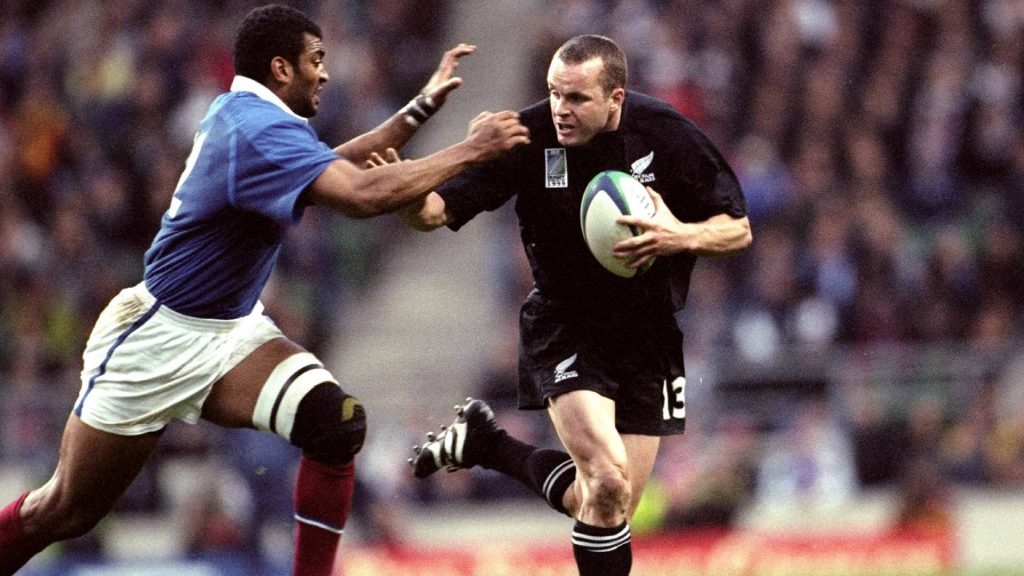
‘Mitch’ went even further.
“Persistent individualism in the face of errors hampers the team and forces us to make tough decisions,” he said. “We look at a player’s character, especially when he is under pressure, and the process we went through in selecting the squad was an exhaustive one. Christian Cullen is entitled to his opinions and what he has to say does not disappoint me.
“We have a settled squad. We have used only 30 players this year. Australia have called on 34 while every other country in the World Cup has resorted to more than 40.”
But when push came to shove in the knockout stages of the competition, the man playing centre was not a centre at all. It was Leon McDonald, the capable Canterbury Crusaders’ fullback.
Like Cullen before him, McDonald was shovelled into an unfamiliar position in order to squeeze more attacking threats into the back three. There were two natural first five-eighths in the back-line which lost to Australia in the semi-final, the mercurial Carlos Spencer with Aaron Mauger outside him, and four back three players – McDonald, Joe Rokocoko and Doug Howlett on the wings, with Mils Muliaina at fullback.
A ‘glue’ player has an understated, but nonetheless powerful impact. They have a rare knack for the small connective details of the action which make the players around them look better. They are happy to do their work in the dark, which allows others to shine, and earn the applause on the bright lights of the stage.
The irony was brought into focus sharply against the underdog Wallabies, with Spencer throwing a long pass which never reached McDonald, and Stirling Mortlock running away to score the crucial intercept try.
It is no coincidence that the two successive World Cups won by New Zealand in 2011 and 2015 occurred with the greatest and most settled centre partnership of the professional era firmly in place. Ma’a Nonu and Conrad Smith played together for the All Blacks on no fewer than 62 occasions. For most of that time, Nonu provided the fireworks, while Conrad was the rock, an expert in all the fine details of the game which are often invisible in real time.
Now the wheel has turned full circle. Ahead of the 2023 World Cup, the current New Zealand coaches still appear torn between selecting an extra back three player at centre (the Blues’ Rieko Ioane) and a ‘glue’ centre out of the Conrad Smith mould in Anton Lienert-Brown. Of the six matches so far in 2021, Ioane and Lienert-Brown have both started on three occasions apiece.
A ‘glue’ player has an understated, but nonetheless powerful impact. They have a rare knack for the small connective details of the action which make the players around them look better. They are happy to do their work in the dark, which allows others to shine, and earn the applause on the bright lights of the stage.
The All Blacks have just such a player, and a worthy successor to Conrad Smith, in the shape of Lienert-Brown. On defence and in the contact zone, he is a leader. In the recent third Bledisloe Cup game versus the Wallabies, he had more significant ruck arrivals than any other New Zealand back: nine on attack, three on defence. Two of those three resulted in turnovers at the tackle:
In the above scenario, Lienert-Brown scents an opportunity to turn the play back inside and create a temporary advantage in numbers at the tackle area. He stays on his feet throughout Len Ikitau’s attempted cleanout, and that frees up his centre partner David Havili to make the steal unopposed:
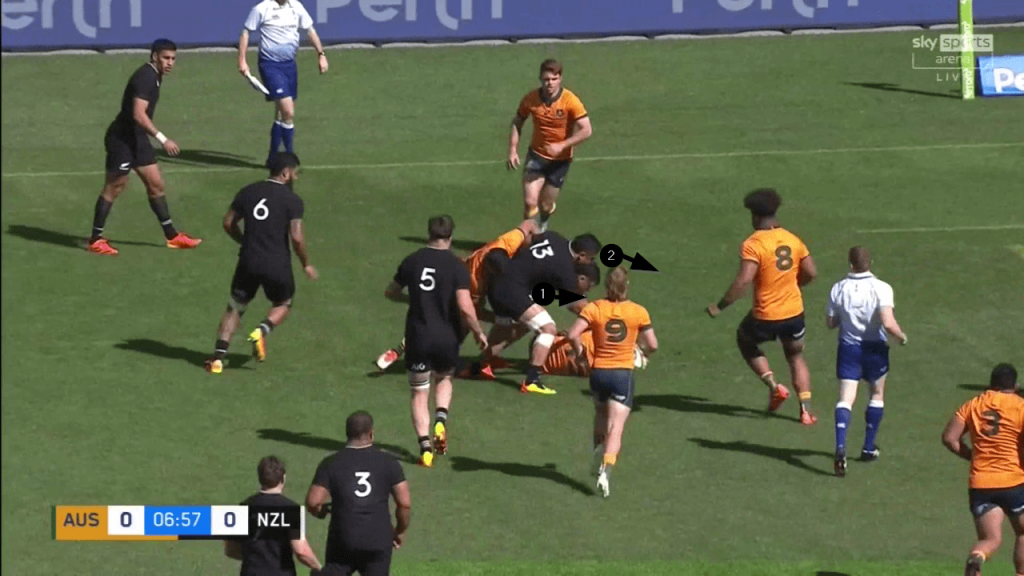
It was not the only time that the two centres dovetailed harmoniously at the tackle area:
On this occasion, Havili tackles, and Lienert-Brown jackals. Neither Tom Banks nor Noah Lolesio are strong enough to remove him.
As the wider of the two centres, Anton Lienert-Brown has an important role in leading the defensive line and making those all-important decisions in the 13 channel, where the opposition attack will look to load up numbers:
In the first example, Lienert-Brown defends high to force the play back inside, and the outcome is a slow, five-second ball for the Wallabies attack. In the second instance, he makes a good read on the circle ball from Matt Philip to Samu Kerevi, setting up an opportunity for the steal by Ardie Savea.
It is the number 13’s job to glue the inside and the outside elements of the defence together, and Lienert-Brown makes accurate decisions in that joint:
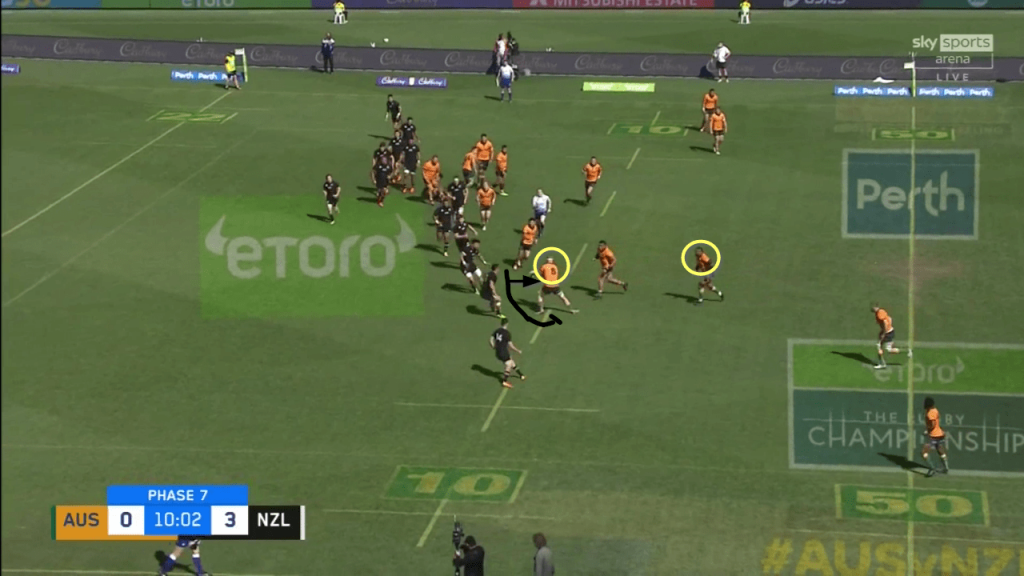
Now look at his first phase defence from lineout against Jordan Petaia and Andrew Kellaway late on in the match:
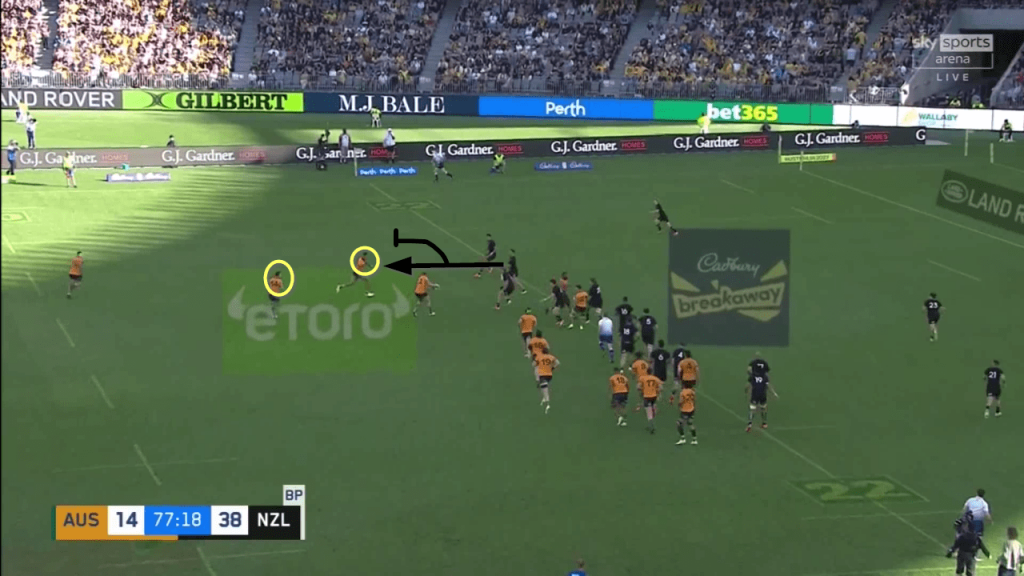
Lienert-Brown forces the offence to blink first and declare their intentions, then moves smoothly off Petaia and on to Kellaway to complete the tackle. He had a 100 per cent tackle record over the two games against the Wallabies.
The unselfish work rate of the Chiefs man off the ball makes the jobs of everyone around him easier:
Lienert-Brown makes another good read, crashing down inside to knock over Michael Hooper. Two phases later, he is back in position on the right edge, creating another on-ball chance for Ethan Blackadder.
With the Havili-Ioane combination in tandem, New Zealand had a lot of problems with their backline cleanout work in the first Test against Fiji:
First David Havili, then Rieko Ioane fail in their efforts to remove Fiji’s Levani Botia from the scene of the action.
Both Anton Lienert-Brown’s cleanout work, and his ball-placement, have the effect of ‘enabling’ the players around him:
In the first example, the Chiefs’ centre is dropping back to protect the kick receipt by Damian McKenzie, then taking on a forward (Australian tighthead prop Allan Alaalatoa) successfully, one-on-one at the cleanout. That oils the wheels for the next phase of attack. In the second he is clearing up ball on retreat with a long and accurate ball placement which sets Akira Ioane steaming down the track.
His work rate off the ball on attack is just as outstanding as it was on defence. Here he is, standing on the left side of an attack:
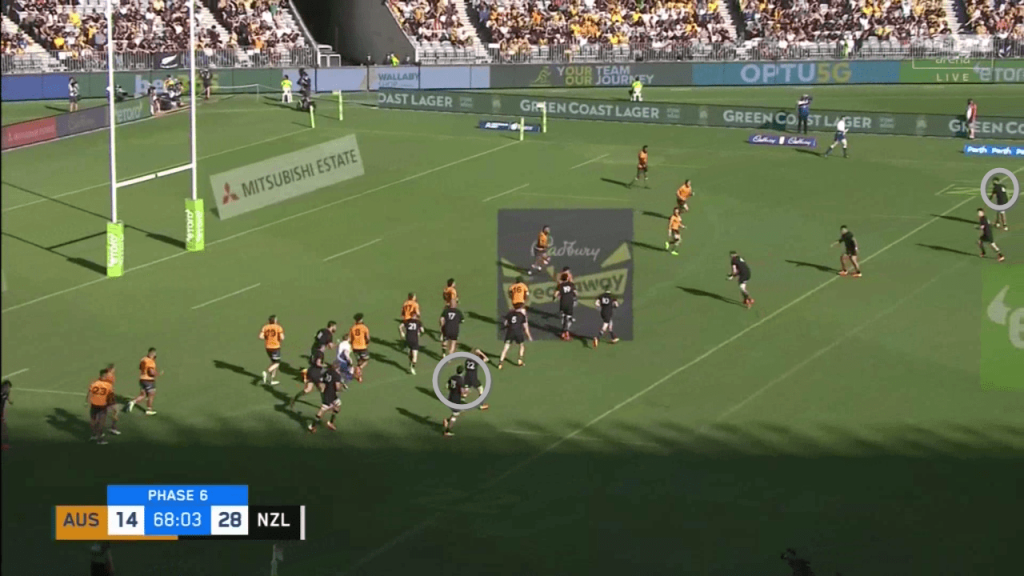
But the move finishes with ALB supporting Akira Ioane out on the right, less than ten seconds later:
It is a reward for the type of efforts which do not seek the limelight or make the highlight reels, but are nonetheless a bedrock of success for any elite-level team. Forget the naiveté of a backline packed with passers and finishers, and the selections of 1999 and 2003 featuring players from the back three at number 13.
Those days are gone. New Zealand needs more of the Conrad Smiths of this world, the guys who can ‘sweep the sheds’ and do all of the dirty, little jobs to the highest possible standard. Cleanout, place, support, read and defend – then rinse and repeat. They have a man who meets all of the requirements, and more, in Anton Lienert-Brown.


Another settling influence at centre, not 2nd, though he can play there, is Jack Goodhue. I think his vision and passing skills are sublime.